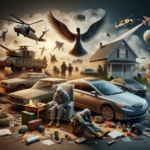Introduction to Military Surplus Vehicles
Military surplus vehicles have long captured the imagination of enthusiasts and collectors alike. These vehicles, once the backbone of military operations, have found new life in civilian settings. From rugged off-road adventures to unique restoration projects, military surplus vehicles offer a glimpse into history while providing practical applications today. Understanding their importance and relevance can inspire both hobbyists and professionals to explore their potential uses.
Types of Military Surplus Vehicles
Military surplus vehicles come in various forms, each with its unique characteristics and applications. Common types include:
- Jeeps and Light Utility Vehicles: Known for their versatility and durability, these vehicles are popular among off-road enthusiasts.
- Trucks and Transport Vehicles: Used for logistical support, these vehicles are appreciated for their robust construction and high load capacity.
- Armored Vehicles: While less common in civilian use, some enthusiasts acquire these for collections or as unique conversation pieces.
Each type of vehicle offers different benefits, from practical transportation solutions to collectible items that preserve military history. The choice often depends on the intended use and personal interest of the buyer.
Acquiring Military Surplus Vehicles
Purchasing a military surplus vehicle involves a few key steps. First, potential buyers should research available options through government auctions or authorized dealers specializing in surplus sales. These vehicles are often sold as-is, requiring careful inspection to ensure they meet safety standards and personal requirements.
Buyers should also consider the legal aspects of owning such vehicles, including registration, insurance, and any modifications needed for roadworthiness. Understanding these factors can help avoid potential pitfalls and ensure a smooth acquisition process.
Restoration and Customization
Restoring a military surplus vehicle can be a rewarding project for those interested in automotive mechanics and history. Many enthusiasts take pride in restoring these vehicles to their original condition or customizing them for modern use.
Restoration involves sourcing original parts, which can sometimes be challenging but rewarding as it preserves the vehicle’s historical integrity. Customization, on the other hand, allows for personal touches, such as upgrading the engine or adding modern features for comfort and convenience.
Practical Uses and Community Involvement
Beyond personal enjoyment, military surplus vehicles have practical applications in various fields. They are often used in agricultural settings, construction, and even emergency response scenarios due to their durability and adaptability.
Additionally, communities of enthusiasts often organize events, such as rallies and exhibitions, to showcase these vehicles and share knowledge. These gatherings foster a sense of community and offer opportunities for learning and networking among like-minded individuals.
Conclusion: Embracing the Legacy of Military Surplus Vehicles
Military surplus vehicles offer a unique blend of historical significance and practical utility. Whether for personal enjoyment, professional use, or community involvement, these vehicles continue to capture the interest of many. By understanding their history, types, and potential applications, enthusiasts and professionals alike can appreciate the enduring legacy of military surplus vehicles.








